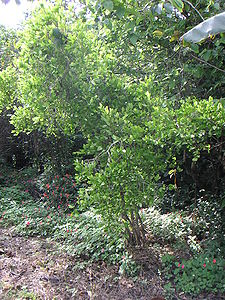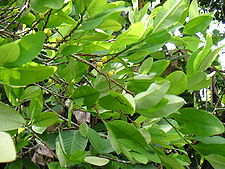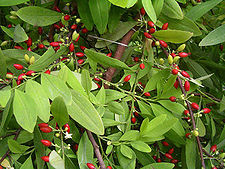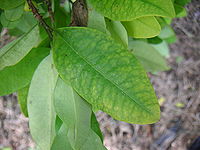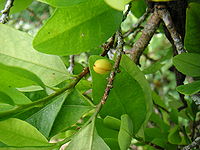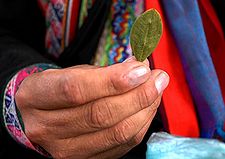Difference between revisions of "Coca" - New World Encyclopedia
Rick Swarts (talk | contribs) (→Uses) |
Rick Swarts (talk | contribs) |
||
| Line 221: | Line 221: | ||
|journal=Tropical Plant Biology|year=2011|volume=4|pages=126–133}}</ref> and Islam 2011<ref name="Islam2011">Islam M. [http://gradworks.umi.com/34/68/3468387.html Tracing the Evolutionary History of Coca (Erythroxylum)] [PhD thesis]. Boulder: University of Colorado, Boulder; 2011</ref>) does not support this linear evolution and instead suggests a second domestication event as the origin of the ''[[Erythroxylum novogranatense]]'' varieties. There may be a common, but undiscovered ancestor.<ref name="Emche2011"/> | |journal=Tropical Plant Biology|year=2011|volume=4|pages=126–133}}</ref> and Islam 2011<ref name="Islam2011">Islam M. [http://gradworks.umi.com/34/68/3468387.html Tracing the Evolutionary History of Coca (Erythroxylum)] [PhD thesis]. Boulder: University of Colorado, Boulder; 2011</ref>) does not support this linear evolution and instead suggests a second domestication event as the origin of the ''[[Erythroxylum novogranatense]]'' varieties. There may be a common, but undiscovered ancestor.<ref name="Emche2011"/> | ||
| − | |||
| − | |||
| − | |||
| − | |||
| − | |||
| − | |||
| − | |||
| − | |||
| − | |||
Revision as of 02:46, 8 August 2013
| Coca | ||||||||||||
|---|---|---|---|---|---|---|---|---|---|---|---|---|
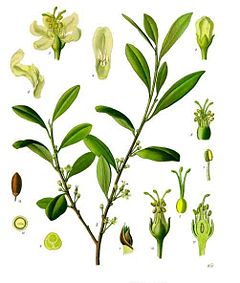 | ||||||||||||
| Scientific classification | ||||||||||||
| ||||||||||||
|
Coca is the common name for four domesticated varieties of tropical plants belonging to the two species Erythroxylum coca and E. novogranatense, whose leaves are used for a variety of purposes, including serving as the source of the drug cocaine. The four varieties are E. coca var. coca (Bolivian or Huánuco coca), E. coca var. ipadu (Amazonian coca), E. novogranatense var. novogranatense (Colombian coca), and E. novogranatense var. truxillense (Trujillo coca). The plant, which is native to the Andes Mountains and Amazon of South America, now also is grown in limited quantities in other regions with tropical climates.
Coca is particularly renowned worldwide for its psychoactive alkaloid, cocaine. While the alkaloid content of coca leaves is low, when the leaves are processed they can provide a concentrated source of cocaine. This purified form, which is used nasally, smoked, or injected, can be very addictive and have deleterious impacts on the brain, heart, respiratory system, kidneys, sexual system, and gastrointestinal tract. It can create a cycle where the user has difficulty experiencing pleasure without the drug.
The coca leaves have been used unprocessed for thousands of years in South America for various religious, social, medicinal, and nutritional purposes, including to control hunger and combat the impacts of high altitudes. Unprocessed coca leaves are also commonly used in the Andean countries to make a herbal tea with mild stimulant effects. However, since the alkaloid cocaine is present in only trace amounts in the leaves, it does not cause the euphoric and psychoactive effects associated with use of the drug.
The Coca-Cola company uses a cocaine-free coca extract. In the early days of the manufacture of Coca-Cola beverage, the formulation did contain some cocaine, although it may never have been more than trace amounts. Cocaine is available as a prescription for such purposes as external application to the skin to numb pain.
Species and varieties
There are two species of cultivated coca, each with two varieties:
- Erythroxylum coca
- Erythroxylum coca var. coca (Bolivian or Huánuco Coca) - well adapted to the eastern Andes of Peru and Bolivia, an area of humid, tropical, montane forest.
- Erythroxylum coca var. ipadu (Amazonian Coca) - cultivated in the lowland Amazon Basin in Peru and Colombia.
- Erythroxylum novogranatense
- Erythroxylum novogranatense var. novogranatense (Colombian Coca) - a highland variety that is utilized in lowland areas. It is cultivated in drier regions found in Colombia. However, E. novogranatense is very adaptable to varying ecological conditions.
- Erythroxylum novogranatense var. truxillense (Trujillo Coca) - grown primarily in Peru and Colombia.
All four of the cultivated cocas were domesticated in pre-Columbian times and are more closely related to each other than to any other species (Plowman 1984). E. novogranatense was historically seen as a variety or subspecies of E. coca (Royal Botanic Gardens 1985). The two subspecies of Erythroxylum coca are almost indistinguishable phenotypically. Erythroxylum novogranatense var. novogranatense and Erythroxylum novogranatense var. truxillense are phenotypically similar, but morphologically distinguishable.
Under the older Cronquist system of classifying flowering plants, coca was placed in an order Linales; more modern systems place it in the order Malpighiales.
Wild populations of Erythroxylum coca var. coca are found in the eastern Andes; the other 3 taxa are only known as cultivated plants.
Description
Coca plants tend to be evergreen shrubs with straight, reddish branches. This later quality is reflected in the name of the genus, Erythroxylum, which is a combination of the Greek erythros, meaning "red," and xylon, meaning "wood" (Mazza 2013). The coca plants tend to have oval to elliptical green leaves tapering at the ends, small yellowish-green flowers with heart-shaped anthers, and fruits in the form of red drupes with a single seed.
The coca plant is largely an understory species, found in moist tropical forests. It is native to the eastern Andes slopes and the Amazon. It does well at high elevations, being cultivated in Bolivia at elevations of 1000 to 2000 meters, but it also is cultivated at lower elevations, including lowland rainforests (Boucher 1991).
Erythroxylum coca
The wild E. coca commonly reaches a height of about 3 to 5.5 meters (12-18 ft), whereas the domestic plant is usually kept to about 6 meters. The stem reaches about 16 centimeters in diameter and has a whitish bark. The branches are reddish, straight, and alternate. There is perennial renewal of the branches in a geometrical progression after being cut (de Medeiros and Rahde 1989; Botany Central 2013).
The leaves of E. coca are green or greenish brown, smooth, opaque, and oval or elliptical, and generally about 1.5 to 3 centimeters (0.6-1.2 inches) wide and reach to 11 centimeters (4.3 inches) long. A special feature of the leaf is that the areolate portion is bordered by two curved, longitudinal lines, with one on either side of the midrib and more pronounced on the underside of the leaf. The small yellowish-green flowers give way to red berries, which are drupaceous and oblong, measuring about 1 centimeter (0.4 inches), and with only one seed (de Medeiros and Rahde 1989; Botany Central 2013).
Erythroxylum novogranatense
E. novogranatense grows to about 3 meters (10 feet), with leaves that are bright green, alternate, obovate or oblong-elliptic and on about a 0.5 centimeter (0.2 in) long petiole. The leaves are about 2 to 6 centimeters (0.8-2.4 in) long and 1 to 3 centimeters (0.4-1.2 in) broad. The flowers are hermaphrodite, solitary or grouped, axillary, and with five yellowish, white petals, about 0.4 centimeters (0.16 in) long and 0.2 centimeters (0.08 in) wide. The fruits are drupes, of oblong shape and red color, with only one oblong seed. They get to be about 0.8 centimeters (0.3 in) long and 0.3 centimeters (0.1 in) in diameter (Mazza 2013).
E. novogranatense var. truxillense differs from E. novogranatense var. novogranatense in that the latter has longitudinal lines on either side of the central nervation (as with E. coca), but this is lacking in the truxillense variety (Mazza 2013).
The species name comes from novus, a, um, meaning "new," and granatensis, meaning "of Granada," from the name "Nueva Granada," the name that Colombia was called at the time of the Spanish conquest (Mazza 2013).
Cocaine and other alkaloids
The coca plant has many alkaloids, such as cocaine. Alkaloids are chemical compounds that are naturally occurring and contain mostly basic nitrogen atoms. Well-known alkaloids include caffeine found in the seed of the coffee plant and the leaves of the tea bush; nicotine found in the nightshade family of plants including the tobacco plant (Nicotiana tabacum); morphine found in poppies; and theobromine found in the cacao plant. Other well-known alkaloids include mescaline, strychnine, quinine, and codeine.
Among the about 14 diverse alkaloids identified in the coca plant are ecgonine, hygrine, truxilline, benzoylecgonine, and tropacocaine. Coca leaves have been reported as having 0.5 to 1.5% alkaloids by dry weight (Royal Botanic Gardens 1985).
The most concentrated alkaloid is cocaine (cocaine (methyl benzoyl ecgonine or benzoylmethylecgonine). Concentrations vary by variety and region, but leaves have been reported variously as between 0.25% and 0.77% (Plowman and Rivier 1983) and as between 0.3% and 1.5% and averaging 0.8% in fresh leaves(Casale and Klein 1993).
Cultivation
Coca is traditionally cultivated in the lower altitudes of the eastern slopes of the Andes (the Yungas), or the highlands depending on the species grown. Coca production begins in the valleys and upper jungle regions of the Andean region, where the countries of Colombia, Peru and Bolivia are host to more than 98 per cent of the global land area planted with coca.[1]
Fresh samples of the dried leaves are uncurled, are of a deep green on the upper, and a grey-green on the lower surface, and have a strong tea-like odor. When chewed, they produce a pleasurable numbness in the mouth, and have a pleasant, pungent taste. They are traditionally chewed with lime to increase the release of the active ingredients from the leaf. Older species have a camphoraceous smell and a brownish color, and lack the pungent taste.
The seeds are sown from December to January in small plots (almacigas) sheltered from the sun, and the young plants when at 40–60 cm in height are placed in final planting holes (aspi), or if the ground is level, in furrows (uachos) in carefully weeded soil. The plants thrive best in hot, damp and humid locations, such as the clearings of forests; but the leaves most preferred are obtained in drier areas, on the hillsides. The leaves are gathered from plants varying in age from one and a half to upwards of forty years, but only the new fresh growth is harvested. They are considered ready for plucking when they break on being bent. The first and most abundant harvest is in March after the rainy season, the second is at the end of June, and the third in October or November. The green leaves (matu) are spread in thin layers on coarse woollen cloths and dried in the sun; they are then packed in sacks, which must be kept dry in order to preserve the quality of the leaves.
History
Traces of coca have been found in mummies dating 3000 years back.[2] Other evidence dates the communal chewing of coca with lime 8000 years back.[3] Extensive archaeological evidence for the chewing of coca leaves dates back at least to the 6th century AD Moche period, and the subsequent Inca period, based on mummies found with a supply of coca leaves, pottery depicting the characteristic cheek bulge of a coca chewer, spatulas for extracting alkali and figured bags for coca leaves and lime made from precious metals, and gold representations of coca in special gardens of the Inca in Cuzco.[4][5]
Coca chewing may originally have been limited to the eastern Andes before its introduction to the Incas. As the plant was viewed as having a divine origin, its cultivation became subject to a state monopoly and its use restricted to nobles and a few favored classes (court orators, couriers, favored public workers, and the army) by the rule of the Topa Inca (1471–1493). As the Incan empire declined, the leaf became more widely available. After some deliberation, Philip II of Spain issued a decree recognizing the drug as essential to the well-being of the Andean Indians but urging missionaries to end its religious use. The Spanish are believed to have effectively encouraged use of coca by an increasing majority of the population to increase their labor output and tolerance for starvation, but it is not clear that this was planned deliberately.[citation needed]
Coca was first introduced to Europe in the 16th century, but did not become popular until the mid-19th century, with the publication of an influential paper by Dr. Paolo Mantegazza praising its stimulating effects on cognition. This led to invention of coca wine and the first production of pure cocaine. Coca wine (of which Vin Mariani was the best-known brand) and other coca-containing preparations were widely sold as patent medicines and tonics, with claims of a wide variety of health benefits. The original version of Coca-Cola was among these. These products became illegal in most countries outside of South America in the early 20th century, after the addictive nature of cocaine was widely recognized. In 1859, Albert Niemann of the University of Göttingen became the first person to isolate the chief alkaloid of coca, which he named "cocaine".[6]
In the early 20th century, the Dutch colony of Java became a leading exporter of coca leaf. By 1912 shipments to Amsterdam, where the leaves were processed into cocaine, reached 1 million kg, overtaking the Peruvian export market. Apart from the years of the First World War, Java remained a greater exporter of coca than Peru until the end of the 1920s.[7] Other colonial powers also tried to grow coca (including the British in India), but with the exception of the Japanese in Formosa, these were relatively unsuccessful.[7]
In recent times (2006), the governments of several South American countries, such as Peru, Bolivia and Venezuela, have defended and championed the traditional use of coca, as well as the modern uses of the leaf and its extracts in household products such as teas and toothpaste.
International prohibition of coca leaf
Coca leaf is the raw material for the manufacture of the drug cocaine, a powerful stimulant and anaesthetic extracted chemically from large quantities of coca leaves. Today, since it has mostly been replaced as a medical anaesthetic by synthetic analogues such as procaine, cocaine is best known as an illegal recreational drug. The cultivation, sale, and possession of unprocessed coca leaf (but not of any processed form of cocaine) is generally legal in the countries – such as Bolivia, Peru, Chile and Argentina – where traditional use is established, although cultivation is often restricted in an attempt to prevent the production of cocaine. In the case of Argentina, it is legal only in some northern provinces where the practice is so common that the state has accepted it.
The prohibition of the use of the coca leaf except for medical or scientific purposes was established by the United Nations in the 1961 Single Convention on Narcotic Drugs. The coca leaf is listed on Schedule I of the 1961 Single Convention together with cocaine and heroin. The Convention determined that "The Parties shall so far as possible enforce the uprooting of all coca bushes which grow wild. They shall destroy the coca bushes if illegally cultivated" (Article 26), and that, "Coca leaf chewing must be abolished within twenty-five years from the coming into force of this Convention" (Article 49, 2.e).[8]
The historic rationale for international prohibition of coca leaf in the 1961 Single Convention comes from "The Commission of Enquiry on the Coca Leaf study" published in 1950. It was requested of the United Nations by the permanent representative of Peru, and was prepared by a commission that visited Bolivia and Peru briefly in 1949 to "investigate the effects of chewing the coca leaf and the possibilities of limiting its production and controlling its distribution." It concluded that the effects of chewing coca leaves were negative, even though chewing coca was defined as a habit, not an addiction.[9][10]
The report was sharply criticised for its arbitrariness, lack of precision and racist connotations.[11] The team members' professional qualifications and parallel interests were also criticised, as were the methodology used and the incomplete selection and use of existing scientific literature on the coca leaf. Questions have been raised as to whether a similar study today would pass the scrutiny and critical review to which scientific studies are routinely subjected.[12]
Despite the legal restriction among countries party to the international treaty, coca chewing and drinking of coca tea is carried out daily by millions of people in the Andes as well as considered sacred within indigenous cultures. Coca consumers claim that most of the information provided about the traditional use of the coca leaf and its modern adaptations are erroneous.[11] This has made it impossible to shed light on the plant's positive aspects and its potential benefits for the physical, mental and social health of the people who consume and cultivate it.[11][12]
In an attempt to obtain international acceptance for the legal recognition of traditional use of coca in their respective countries, Peru and Bolivia successfully led an amendment, paragraph 2 of Article 14 into the 1988 United Nations Convention Against Illicit Traffic in Narcotic Drugs and Psychotropic Substances, stipulating that measures to eradicate illicit cultivation and to eliminate illicit demand "should take due account of traditional licit use, where there is historic evidence of such use."[13] Bolivia also made a formal reservation to the 1988 Convention, which required countries to adopt measures to establish the use, consumption, possession, purchase or cultivation of the coca leaf for personal consumption as a criminal offence. Bolivia stated that "the coca leaf is not, in and of itself, a narcotic drug or psychotropic substance" and stressed that its "legal system recognizes the ancestral nature of the licit use of the coca leaf, which, for much of Bolivia's population, dates back over centuries."[13][14]
However, the International Narcotics Control Board (INCB) – the independent and quasi-judicial control organ for the implementation of the United Nations drug conventions – denied the validity of article 14 in the 1988 Convention over the requirements of the 1961 Convention, or any reservation made by parties, since it does not "absolve a party of its rights and obligations under the other international drug control treaties."[15]
The INCB stated in its 1994 Annual Report that "mate de coca, which is considered harmless and legal in several countries in South America, is an illegal activity under the provisions of both the 1961 Convention and the 1988 Convention, though that was not the intention of the plenipotentiary conferences that adopted those conventions."[16] It implicitly also dismissed the original report of the Commission of Enquiry on the Coca Leaf by recognizing that "there is a need to undertake a scientific review to assess the coca-chewing habit and the drinking of coca tea."[17]
Nevertheless, the INCB on other occasions did not show signs of an increased sensitivity towards the Bolivian claim on the rights of their indigenous population, and the general public, to consume the coca leaf in a traditional manner by chewing the leaf, and drinking coca tea, as "not in line with the provisions of the 1961 Convention."[18][19] The Board considered Bolivia, Peru and a few other countries that allow such practises to be in breach with their treaty obligations, and insisted that "each party to the Convention should establish as a criminal offence, when committed intentionally, the possession and purchase of coca leaf for personal consumption."[20]
In reaction to the 2007 Annual Report of the INCB, the Bolivian government announced that it would formally issue a request to the United Nations to unschedule the coca leaf of List 1 of the 1961 UN Single Convention.[21] Bolivia led a diplomatic effort to do so beginning in March 2009, but eighteen countries out of a total of 184,those 18 being listed as followed (chronologically: the United States, Sweden, United Kingdom, Latvia, Japan, Canada, France, Germany, Bulgaria, Slovakia, Denmark, Estonia, Italy, Mexico, Russian Federation, Malaysia, Singapore, and Ukraine) objected to the change before the January 2011 deadline. A single objection would have been sufficient to block the modification. The legally unnecessary step of supporting the change was taken formally by Spain, Ecuador, Venezuela, and Costa Rica.[22] In June 2011, Bolivia moved to denounce the 1961 Convention over the prohibition of the coca leaf.[23]
{{#invoke:Message box|ambox}} Since the 1980s, the countries in which coca is grown have come under political and economic pressure from the United States to restrict the cultivation of the crop in order to reduce the supply of cocaine on the international market.[11]
Article 26 of the Single Convention on Narcotic Drugs requires nations that allow the cultivation of coca to designate an agency to regulate said cultivation and take physical possession of the crops as soon as possible after harvest, and to destroy all coca which grows wild or is illegally cultivated. The effort to enforce these provisions, referred to as coca eradication, has involved many strategies, ranging from aerial spraying of herbicides on coca crops to assistance and incentives to encourage farmers to grow alternate crops.[24]
This effort has been politically controversial,[25] with proponents claiming[citation needed] that the production of cocaine is several times the amount needed to satisfy legal demand and inferring that the vast majority of the coca crop is destined for the illegal market. As per the proclaimed view, this would not only contributes to the major social problem of drug abuse but also financially supports insurgent groups that collaborate with drug traffickers in some cocaine-producing territories. Critics of the effort claim[11] that it creates hardship primarily for the coca growers, many of whom are poor and have no viable alternative way to make a living, causes environmental problems, that it is not effective in reducing the supply of cocaine, in part because cultivation can move to other areas, and that any social harm created by drug abuse is only made worse by the War on Drugs.[11] The environmental problems include "ecocide", where vast tracts of land and forest are sprayed with glyphosate or Roundup, with the intention of eradicating the coca plant.[11] However, the incidental environmental damage is severe, because many plant species are wiped out in the process.[11]
Coca has been reintroduced to the United States as a flavoring agent in the herbal liqueur Agwa de Bolivia.[citation needed]
Boliviana negra, a genetically engineered type of coca, resists glyphosate herbicides and increases yields.
Legal status by country
Outside of South America, most countries' laws make no distinction between the coca leaf and any other substance containing cocaine, so the possession of coca leaf is prohibited. In South America coca leaf is illegal in both Paraguay and Brazil.
In the Netherlands, coca leaf is legally in the same category as cocaine, both are List I drugs of the Opium Law. The Opium Law specifically mentions the leafs of the plants of the genus Erythroxylon. However, the possession of living plants of the genus Erythroxylon are not actively prosecuted, even though they are legally forbidden.
In the United States, a Stepan Company plant in Maywood, New Jersey is a registered importer of coca leaf. The company manufactures pure cocaine for medical use and also produces a cocaine-free extract of the coca leaf, which is used as a flavoring ingredient in Coca-Cola. Other companies have registrations with the DEA to import coca leaf according to 2011 Federal Register Notices for Importers,[26] including Johnson Matthey, Inc, Pharmaceutical Materials; Mallinckrodt Inc; Penick Corporation; and the Research Triangle Institute. According to the Bolivian press,[citation needed] Coca-Cola imported 204 tons of coca leaf in 1996.
Uses
Medicine
Traditional medical uses of coca are foremost as a stimulant to overcome fatigue, hunger, and thirst. It is considered particularly effective against altitude sickness.[11] It also is used as an anesthetic and analgesic to alleviate the pain of headache, rheumatism, wounds and sores, etc. Before stronger anaesthetics were available, it also was used for broken bones, childbirth, and during trephining operations on the skull.[11] The high calcium content in coca explains why people used it for bone fractures.[11] Because coca constricts blood vessels, it also serves to oppose bleeding, and coca seeds were used for nosebleeds. Indigenous use of coca has also been reported as a treatment for malaria, ulcers, asthma, to improve digestion, to guard against bowel laxity, as an aphrodisiac, and credited with improving longevity. Modern studies have supported a number of these medical applications.[27][11]
Nutrition
Raw coca leaves, chewed or consumed as tea or mate de coca, are rich in nutritional properties. Specifically, the coca plant contains essential minerals (calcium, potassium, phosphorus), vitamins (B1, B2, C, and E) and nutrients such as protein and fiber.[28][29]
Traditional preparation
Traditionally, coca leaves are prepared either to chew or as a tea[30] (mate de coca).
Chew
Template:Refimprove section In Bolivia bags of coca leaves are sold in local markets and by street vendors. The activity of chewing coca is called mambear, chacchar or acullicar, borrowed from Quechua, coquear (northern Argentina), or in Bolivia, picchar, derived from the Aymara language. The Spanish masticar is also frequently used, along with the slang term "bolear," derived from the word "bola" or ball of coca pouched in the cheek while chewing. Typical coca consumption is about 2 ounces (57 grams) per day,[citation needed] and contemporary methods are believed to be unchanged from ancient times.[citation needed] Coca is kept in a woven pouch (chuspa or huallqui). A few leaves are chosen to form a quid (acullico) held between the mouth and gums. Doing so may cause a tingling and numbing sensation in their mouths. (The formerly used dental anaesthetic Novocaine has a similar effect.) Chewing coca leaves is most common in indigenous communities across the central Andean region,[31] particularly in places like the highlands of Colombia, Bolivia and Peru, where the cultivation and consumption of coca is as much a part of the national culture similar to chicha, like wine is to France or beer is to Germany.[citation needed] It also serves as a powerful symbol of indigenous cultural and religious identity, amongst a diversity of indigenous nations throughout South America.[31]
Coca is still chewed in the traditional way, with a tiny quantity of ilucta (a preparation of the ashes of the quinoa plant) added to the coca leavesTemplate:Contradiction-inline; it softens their astringent flavor and activates the alkaloids.[citation needed] Other names for this basifying substance are llipta in Peru and the Spanish word lejía, lye in English. The consumer carefully uses a wooden stick (formerly often a spatula of precious metal) to transfer an alkaline component into the quid without touching his flesh with the corrosive substance. The alkali component, usually kept in a gourd (ishcupuro or poporo), can be made by burning limestone to form unslaked quicklime, burning quinoa stalks, or the bark from certain trees, and may be called ilipta, tocra or mambe depending on its composition.[4][5] Many of these materials are salty in flavor, but there are variations. The most common base[citation needed] in the La Paz area of Bolivia is a product known as lejía dulce (sweet lye), which is made from quinoa ashes mixed with aniseed and cane sugar, forming a soft black putty with a sweet and pleasing flavor. In some places, baking soda is used under the name bico.
In the Sierra Nevada de Santa Marta, on the Caribbean Coast of Colombia, coca is consumed[31] by the Kogi, Arhuaco and Wiwa by using a special device called poporo.[31] The poporo is the mark of manhood. It represents the womb and the stick is a phallic symbol. The movements of the stick in the poporo symbolize the sexual act. For a man the poporo is a good companion that means "food", "woman", "memory", and "meditation". It is important to stress that poporo is the symbol of manhood.[citation needed] But it is the woman who gives men their manhood. When the boy is ready to be married, his mother will initiate him in the use of the coca. This act of initiation is carefully supervised by the Mamo, a traditional priest-teacher-leader.[citation needed]
Tea
Template:Refimprove section
Although coca leaf chewing is common only among the indigenous populations,[11] the consumption of coca tea (Mate de coca) is common among all sectors of society in the Andean countries, especially due to their high elevations from sea level,[11] and is widely held to be beneficial to health, mood, and energy.[11] Coca leaf is sold packaged into teabags in most grocery stores in the region, and establishments that cater to tourists generally feature coca tea.
Religion
Coca has also been a vital part of the religious cosmology of the Andean peoples of Peru, Bolivia, Ecuador, Colombia, northern Argentina, and Chile from the pre-Inca period through the present. Coca leaves play a crucial part in offerings to the apus (mountains), Inti (the sun), or Pachamama (the earth). Coca leaves are also often read in a form of divination analogous to reading tea leaves in other cultures. As one example of the many traditional beliefs about coca, it is believed by the miners of Cerro de Pasco to soften the veins of ore, if masticated (chewed) and thrown upon them (see Cocomama in Inca mythology).[citation needed] In addition, coca use in shamanic rituals is well documented wherever local native populations have cultivated the plant. For example, the Tayronas of Colombia's Sierra Nevada de Santa Marta used to chew the plant before engaging in extended meditation and prayer.[31]
Pharmacological? cocaine, drug
Evolution
There are two main theories relating to the evolution of the cultivated cocas. The first (put forth by Plowman[32] and Bohm [33]) suggests that Erythroxylum coca var. coca is ancestral, while Erythroxylum novogranatense var. truxillense is derived from it to be drought tolerant, and Erythroxylum novogranatense var. novogranatense derived from Erythroxylum novogranatense var. truxillense.
Recent research based on genetic evidence (Johnson et al. in 2005,[34] Emche et al. in 2011,[35] and Islam 2011[36]) does not support this linear evolution and instead suggests a second domestication event as the origin of the Erythroxylum novogranatense varieties. There may be a common, but undiscovered ancestor.[35]
ReferencesISBN links support NWE through referral fees
- ↑ Dion, Michelle L and Russler,Catherine (2008). Eradication Efforts, The State, Displacement And Poverty: Explaining Coca Cultivation In Colombia During Plan Colombia. Journal of Latin American Studies 40.3: 399–421.
- ↑ and Rivera MA, Aufderheide AC, Cartmell LW, Torres CM, Langsjoen O (12 2005). Antiquity of coca-leaf chewing in the south central Andes: a 3,000 year archaeological record of coca-leaf chewing from northern Chile. Journal of Psychoactive Drugs 37(4): 455–458.
- ↑ Dillehay et al (2010). Early Holocene coca chewing in northern Peru. Antiquity 84 (326): 939–953.
- ↑ 4.0 4.1 Robert C. Peterson, Ph.D. (1977-05). NIDA research monograph #13: Cocaine 1977, Chapter I. Retrieved 2007-05-26.
- ↑ 5.0 5.1 Eleanor Carroll, M.A.. Coca: the plant and its use. Retrieved 2007-05-26.
- ↑ Inciardi, James A. (1992). The War on Drugs II. Mayfield Publishing Company. ISBN 1-55934-016-9.
- ↑ 7.0 7.1 Musto, DF (1998). International traffic in coca through the early 20th century. Drug and Alcohol Dependence 49 (2): 145–156.
- ↑ Single Convention on Narcotic Drugs
- ↑ Commission of Enquiry on the Coca Leaf, UNGASS 10-year review website, Transnational Institute
- ↑ The Commission of Enquiry on the Coca Leaf, Bulletin on Narcotics - 1949 Issue 1
- ↑ 11.00 11.01 11.02 11.03 11.04 11.05 11.06 11.07 11.08 11.09 11.10 11.11 11.12 11.13 11.14 Transnational Institute - Coca Myths, 2009
- ↑ 12.0 12.1 Coca Yes, Cocaine No? Legal Options for the Coca Leaf, Transnational Institute, Drugs & Conflict Debate Paper 13, May 2006
- ↑ 13.0 13.1 The resolution of ambiguities regarding coca, Transnational Institute, March 2008
- ↑ Status of treaty adherence, United Nations Convention against Illicit Traffic in Narcotic Drugs and Psychotropic Substances
- ↑ Report of the International Narcotics Control Board for 2007, paragraph 220
- ↑ Evaluation of the effectiveness of the international drug control treaties, Supplement to the INCB Annual Report for 1994 (Part 3)
- ↑ Evaluation of the effectiveness of the international drug control treaties, Supplement to the INCB Annual Report for 1994 (Part 1)
- ↑ Report of the International Narcotics Control Board for 2007, paragraph 217
- ↑ Response to the 2007 Annual Report of the International Narcotics Control Board, International Drug Policy Consortium (IDPC), March 2008
- ↑ Report of the International Narcotics Control Board for 2007, paragraph 219
- ↑ Letter Evo Morales to UN Secretary General Ban Ki-moon, March 8, 2008
- ↑ Objections and support for Bolivia's coca amendment. Transnational Institute.
- ↑ "Aprueban denuncia contra la Convención de Viena", Los Tiempos, 2011-06-23. Retrieved 2011-06-23.
- ↑ Transnational Institute - Coca Myths, 2009.
- ↑ Failed States and failed policies: how to stop the drug wars. The Economist, May 2009
- ↑ Importers Notice of Registration - 2011. deaDiversion.usdoj.gov. Retrieved 2012-11-09.
- ↑ Cite error: Invalid
<ref>tag; no text was provided for refs namedWeil - ↑ James, A., Aulick, D., Plowman, T., 1975 "Nutritional Value of Coca", Botanical Museum Leaflets, Harvard University 24 (6): 113-119.
- ↑ Harvard Study - Nutritional Value of Coca Leaf (Duke, Aulick, Plowman 1975)
- ↑ Drugs and Democracy | Coca leaf: Myths and Reality. Tni.org (2011-02-18). Retrieved 2012-11-09.
- ↑ 31.0 31.1 31.2 31.3 31.4 Museo del Oro, Banco de la Republica. Museo del Oro, Colombia (in (Spanish)). Banrep.gov.co. Retrieved 2012-11-09.
- ↑ Plowman T. "The Origin, Evolution, and Diffusion of Coca, Erythroxylum spp., in South and Central America." In: Stone D, ed. Pre-Columbian Plant Migration. Papers of the Peabody Museum of Archaeology and Ethnology. Harvard University. Vol 76. Cambridge MA: Harvard University Press; 1984. p. 125-163.
- ↑ Bohm, B and Ganders F, Plowman T (1982). Biosystematics and Evolution of Cultivated Coca (Erythroxylaceae). Systematic Botany 7(2): 121–133.
- ↑ Johnson, E and Zhang D, Emche S (2005). Inter- and Intra-specific Variation among Five Erythroxylum Taxa Assessed by AFLP. Annals of Botany 95: 601–608.
- ↑ 35.0 35.1 Emche, S and Zhang D, Islam M, Bailey B, Meinhardt L (2011). AFLP Phylogeny of 36 Erythroxylum Species Genetic Relationships Among Erythroxylum Species Inferred by AFLP Analysis. Tropical Plant Biology 4: 126–133.
- ↑ Islam M. Tracing the Evolutionary History of Coca (Erythroxylum) [PhD thesis]. Boulder: University of Colorado, Boulder; 2011
- Boucher, D. H. 1991. Cocaine and the coca plant. BioScience 41(2): 72-76.
Plowman T. "The Origin, Evolution, and Diffusion of Coca, Erythroxylum spp., in South and Central America." In: Stone D, ed. Pre-Columbian Plant Migration. Papers of the Peabody Museum of Archaeology and Ethnology. Harvard University. Vol 76. Cambridge MA: Harvard University Press; 1984. p. 125-163.</ref>
Plowman, T; Rivier L (1983). "Cocaine and Cinnamoylcocaine content of thirty-one species of Erythroxylum (Erythroxylaceae)". Annals of Botany (London) 51: 641–659.
"Illicit Production of Cocaine - [www.rhodium.ws]". Erowid.org. Retrieved 2013-03-26.
Casale JF, Klein RFX
Forensic Science Review 5, 95-107 (1993)
http://www.erowid.org/archive/rhodium/chemistry/cocaine.illicit.production.html
- Mazza, G. 2013. Erythroxylum novogranatense. Photomazza.com. Retrieved August 6, 2013.
- Botany Central. 2013. Erythroxylum coca: The coca plant. Botany Central. Retrieved August 6, 2013.
- de Medeiros, M. S. C., and A. Furtado Rahde. 1989. Erythroxylum coca Lam. inchem.org. Retrieved August 6, 2013.
- Royal Botanic Gardens, Kew. 1985. Entry for Erythroxylum coca Lam. [family ERYTHROXYLACEAE]. JSTOR. Retrieved August 6, 2013.
- Turner C. E., Elsohly M. A., Hanuš L., Elsohly H. N. Isolation of dihydrocuscohygrine from Peruvian coca leaves. Phytochemistry 20 (6), 1403-1405 (1981)
- History of Coca. The Divine Plant of the Incas by W. Golden Mortimer, M.D. 576 pp. And/Or Press San Francisco, 1974. This title has no ISBN.
This article incorporates text from the Encyclopædia Britannica Eleventh Edition, a publication now in the public domain.
http://chestofbooks.com/food/beverages/A-Treatise-On-Beverages/Coca-Plant.html#.UgBXU20phXF#ixzz2b9MIcIZW
Title A Treatise On Beverages or The Complete Practical Bottler
Author Charles Herman Sulz
Publisher Dick & Fitzgerald Publishers
Year 1888
Copyright 1888, Charles Herman Sulz
Amazon A Treatise On Beverages
Read more: http://chestofbooks.com/food/beverages/A-Treatise-On-Beverages/index.html#.UgBXOm0phXE#ixzz2b9MB7GaN
External links
- Shared Responsibility
- Coca leaf: Myths and Reality website of the Transnational Institute (TNI)
- Unscheduling the coca leaf, UN Drug Control website of the Transnational Institute (TNI)
- Coca leaf news page
Template:Ancient anaesthesia-footer
Credits
New World Encyclopedia writers and editors rewrote and completed the Wikipedia article in accordance with New World Encyclopedia standards. This article abides by terms of the Creative Commons CC-by-sa 3.0 License (CC-by-sa), which may be used and disseminated with proper attribution. Credit is due under the terms of this license that can reference both the New World Encyclopedia contributors and the selfless volunteer contributors of the Wikimedia Foundation. To cite this article click here for a list of acceptable citing formats.The history of earlier contributions by wikipedians is accessible to researchers here:
The history of this article since it was imported to New World Encyclopedia:
Note: Some restrictions may apply to use of individual images which are separately licensed.
